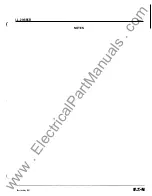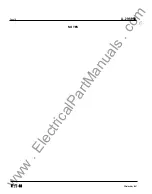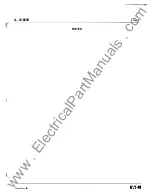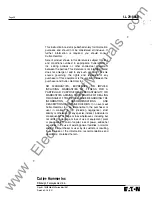
I.L. 29-8858
4.2 Long Delay Current Setting
There are eight (8) available Long Delay Settings, as
illustrated in Fig. 4.1. Each setting, called
"1,"
is
expressed as a multiple (ranging from .5 to 1) of the rat
ing plug current
(In)·
Note: "/,''is also the basis for the Short-Delay Cur
rent Setting. (See Section 4.4.)
Lon� Delay
Settmg 1,
OJx
In
�
t,
t,
Available Settings
.5, .6, .7, .8,
.85, .9, .95, 1
In
of
Rating
Amperes
llnl
Fig. 4. 1
Long Delay Current Settings
4.3 Long Delay Time Setting
There are eight (8) available Long Delay Time Settings,
as illustrated in Fig. 4. 2, ranging from 2 to 24 seconds.
These settings are the total clearing times when the cur
rent value equals six (6) times
1,.
6xt,
Fig. 4.2
Long Delay Time Settings
Notes:
Available Settings
2. 4. 7, 10,
12, 15, 20. 24
Seconds at
6
Times
Long Delay Setting
(I,)
1) In addition to the standard Long Delay Protection
Element, the Digitrip RMS 510 trip unit also has a
Long Time Memory function (LTM), which serves
to protect load circuits from the effects of
repeated overload conditions. If a breaker is
reclosed soon after a Long Delay Trip, and the
current again exceeds the Long Delay Setting,
1,
the LTM automatically reduces the time to trip, to
Effective May 1997
Page 7
allow for the fact that the load circuit temperature
is already higher than normal, due to the prior
overload condition. Each time an overload condi
tion is repeated, the LTM causes the breaker to
trip in a time progressively earlier than the "Long
Delay Time Setting". When the load current
returns to normal, the LTM begins to reset; and
after about 10 m inutes it has reset fully, so that
next Long Delay trip time will again be the "Set
ting" value.
In certain applications it may be desirable to dis
able the LTM function. The LTM function can be
disabled by (first opening the breaker and then)
removing the Rating Plug (See Figures 1 and 6),
and lastly moving the LTM jumper (inside the rat
ing plug cavity, See figure 4.2.1) to its "INAC
TIVE" connection. (You can enable the LTM
function again any time you wish by moving the
LTM jumper back to its original "ACTIVE" con
nection.)
Rating Plug Cavity
-�---
©©
----- ---i,./1--- --- -
Standard from Factory
"L TM
Active"
Rating Plug Cavity
-- �----
"L TM
Inactive" ------
Fig. 4.2. 1 Long Time Memory "LTM" Jumper
The action of the LTM is a factor to consider in
performing multiple Long Delay Time tests. (See
Section 5.4. )
2) There is a condition under which the Long Delay
Trip LED can erroneously indicate a LOT has
occurred, even though the breaker is still closed.
This can happen when an overload current
momentarily exceeds the Long Delay Current
Setting, 1, so that the Long Delay LED flashes
"RED" to indicate the overload condition . Then if,
at the very moment when the LED is "ON", the
load current would then su ddenly drop to a value
less than 10% of the breaker frame (or current
sensor) rating, the trip unit stops functioning
while the "4bit Latch Chip" (See Fig. 3) is· set and
the LED remains Lighted. If the current would
again increase to a value above the Long Delay
Current Setting, 1, and then return to normal, the
www
. ElectricalPartManuals
. com


































